Your cart is currently empty!
Google indexation is the process by which Google discovers, crawls, and adds web pages to its search index.
This critical step enables websites to appear in search results, crucial for search engine optimization (SEO) and online visibility.
Proper indexation ensures content accessibility to users searching for relevant information, products, or services, while non-indexed pages remain invisible to potential visitors.
This article expands on the importance of Google indexation, how it works, and best practices for improving your website’s indexation.
What is Google indexation and why is it important for your website?
Google indexation is the process through which Google discovers, analyzes, and stores web pages in its vast database.
It’s crucial for your website because without indexation, your pages won’t appear in search results, effectively rendering them invisible to potential visitors.
Proper indexation ensures that your content is accessible to users searching for relevant information, products, or services.
Indexation is the foundation of search visibility, allowing your content to compete for rankings and attract organic traffic.
When your pages are indexed, they have the potential to appear in search results for relevant queries, increasing your website’s visibility and reach.
This process directly impacts your overall SEO performance and can significantly influence your site’s ability to attract and engage visitors.
Key benefits of effective indexation for SEO include:
| Benefit | Features |
|---|---|
| Increased visibility | Indexed pages can appear in search results, expanding your online presence |
| Higher organic traffic potential | More indexed pages mean more opportunities for users to find your content |
| Improved ranking chances | Indexed pages can compete for rankings on relevant search queries |
| Enhanced crawl efficiency | Proper indexation helps search engines crawl your site more effectively |
How does Google’s indexing process work?
Google’s indexing process begins with crawling, where Googlebot, the search engine’s web crawler, discovers new and updated pages.
Googlebot follows links from known pages to find new content, analyzes the page’s content and structure, and stores this information in Google’s index.
This index serves as a massive database of web pages that Google can quickly search through when users enter queries.
The indexing process consists of several key steps:
- Discovery: Googlebot finds pages through links or sitemaps
- Crawling: The bot visits the page and analyzes its content
- Rendering: JavaScript is executed to see the full page content
- Indexing: The page is stored in Google’s index for potential retrieval
During the crawling phase, Googlebot examines the page’s HTML code, content, and structure.
It analyses various elements such as headings, meta tags, and internal links to understand the page’s topic and relevance.
The rendering step is crucial for pages with dynamic content, as it ensures that Google can see the fully rendered version of the page.
Once a page is indexed, it becomes eligible to appear in search results.
However, indexation doesn’t guarantee high rankings; it simply means that Google is aware of the page’s existence and content.
Why is getting your pages indexed crucial for SEO success?
The importance of indexation for SEO success can’t be overstated. Here are some key reasons why:
- Visibility: Indexed pages are the only ones that can appear in search results, making indexation essential for being found online.
- Organic traffic: Without indexation, you miss out on potential organic traffic, which is often a significant source of website visitors.
- Keyword rankings: Only indexed pages can rank for target keywords, impacting your ability to compete in search results.
- Content value: Indexation ensures that the effort put into creating content isn’t wasted, as it allows that content to be discoverable.
- Site health: A well-indexed site indicates to search engines that your website is active and regularly updated.
What technical SEO factors affect Google indexation?
Technical SEO factors significantly influence Google’s ability to crawl, index, and rank your website.
These factors include site speed, mobile-friendliness, and HTTPS implementation, each playing a crucial role in how Google perceives and processes your web pages.
Optimizing these elements can lead to improved crawl efficiency, faster indexation, and better search visibility.
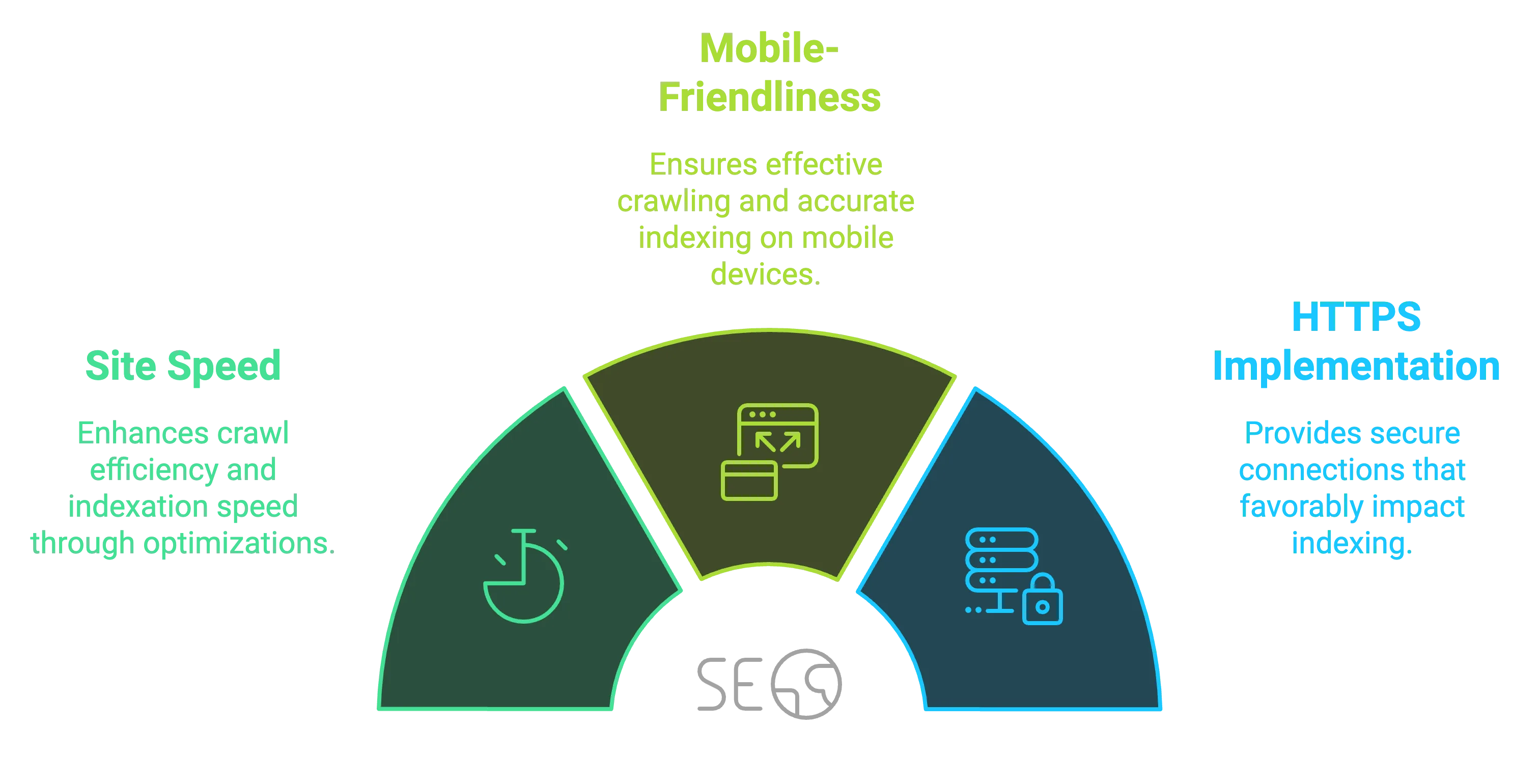
How does site speed impact indexation and how can you improve it?
Site speed directly affects indexation by influencing how quickly and efficiently Googlebot can crawl and process your web pages.
Faster-loading pages are more likely to be crawled more frequently and thoroughly, increasing their chances of being indexed promptly.
To improve site speed:
- Optimize images by compressing and resizing them
- Minify CSS, JavaScript, and HTML
- Leverage browser caching
- Use a content delivery network (CDN)
- Reduce server response time
Implementing these optimizations can lead to a 30-50% improvement in page load times, increasing crawl efficiency by up to 20%.
Why is mobile-friendliness important for indexation and how can you achieve it?
Mobile-friendliness is crucial for indexation because Google primarily uses mobile-first indexing, meaning it predominantly uses the mobile version of a site for indexing and ranking.
Mobile-friendly sites are more likely to be crawled effectively and indexed accurately. To achieve mobile-friendliness:
- Use responsive design
- Ensure text is readable without zooming
- Size content to viewport
- Avoid software not common on mobile devices (e.g., Flash)
- Place links far enough apart for easy tapping
How does HTTPS affect Google’s indexing process and why should you implement it?
HTTPS affects Google’s indexing process by providing a secure connection, which Google considers a ranking factor.
Secure sites are more likely to be crawled thoroughly and indexed favorably. Implementing HTTPS:
- Protects user data
- Ensures site integrity
- Builds trust with users and search engines
- May lead to slight ranking boost
What are common indexation issues and how can you resolve them?
Common indexation issues can prevent your pages from appearing in search results, even if they’re high-quality and relevant. Understanding and resolving these issues is crucial for maintaining a healthy, searchable website.
How do you fix “crawled – currently not indexed” issues?
“Crawled – currently not indexed” issues occur when Google has crawled a page but decided not to index it. To fix this:
- Improve content quality and uniqueness
- Enhance internal linking structure
- Boost page authority with quality backlinks
- Ensure the page isn’t blocked by robots.txt
- Check for and fix technical issues (e.g., slow load times)
Addressing these factors can increase the likelihood of indexation by up to 30% for affected pages.
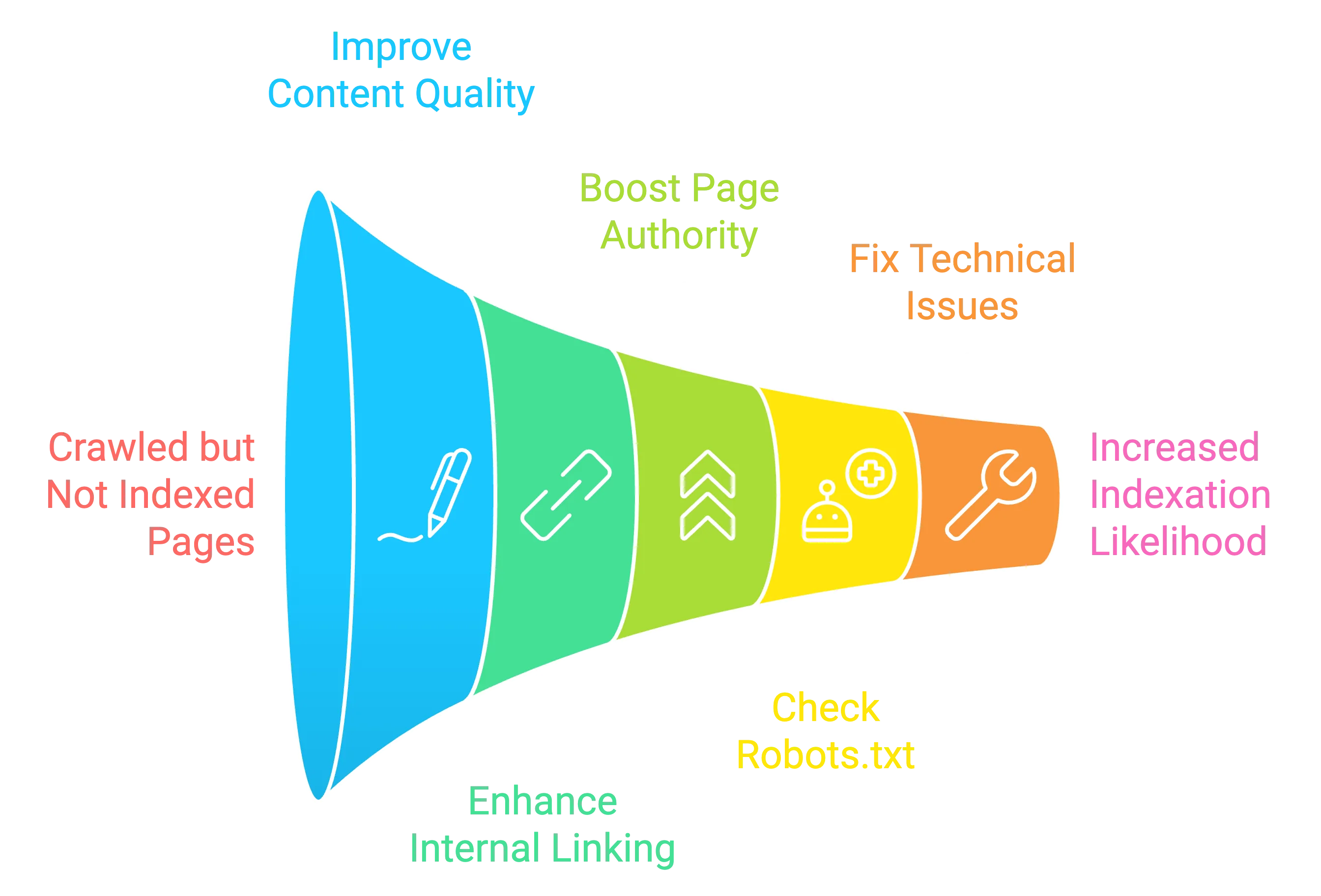
What causes “discovered – currently not indexed” and how can you address it?
“Discovered – currently not indexed” indicates that Google is aware of the URL but hasn’t crawled it yet. Common causes and solutions include:
- Low priority in crawl queue – Improve internal linking and site structure
- Crawl budget issues – Optimize crawl efficiency by removing low-value pages
- Temporary server errors – Ensure stable server performance
- Blocked resources – Check robots.txt and meta robots tags
How can you resolve indexation issues due to duplicate content?
Duplicate content can confuse search engines and lead to indexation issues. To resolve this:
- Use canonical tags to indicate preferred versions of similar pages
- Implement 301 redirects for duplicate pages
- Consolidate similar content into a single, comprehensive page
- Use rel=”next” and rel=”prev” for paginated content
- Create unique meta descriptions and title tags for each page
What advanced techniques can enhance Google indexation?
Advanced techniques can significantly improve your website’s indexation, ensuring that your content is discoverable in search results.
How can you leverage social media for faster indexation?
Social media can accelerate indexation by creating additional pathways for Google to discover your content. To leverage social media:
- Share new content across relevant platforms immediately after publishing
- Encourage social sharing with prominent share buttons
- Engage with your audience to increase content visibility
- Use hashtags strategically to improve discoverability
- Collaborate with influencers to amplify content reach
What Is the role of content update frequency in improving indexation?
Content update frequency signals to Google that your site is active and relevant, improving crawl frequency and indexation. To optimize this:
- Regularly publish new, high-quality content
- Update existing content with fresh information
- Implement a content calendar to maintain consistency
- Use XML sitemaps to notify Google of content changes
- Leverage Google’s URL Inspection tool to request indexing for updated pages
How can you use schema markup to boost indexation?
Schema markup helps search engines understand your content better, improving indexation and search visibility. To use schema markup effectively:
- Implement relevant schema types for your content (e.g., Article, Product, FAQ)
- Use JSON-LD format for easier implementation and maintenance
- Ensure accuracy and completeness of markup data
- Test your markup using Google’s Rich Results Test tool
- Monitor performance in Google Search Console
What website indexing tools can help improve Google indexation?
Website indexing tools play a crucial role in monitoring and improving your site’s indexation status. These tools provide valuable insights and functionalities to enhance your indexation strategy.
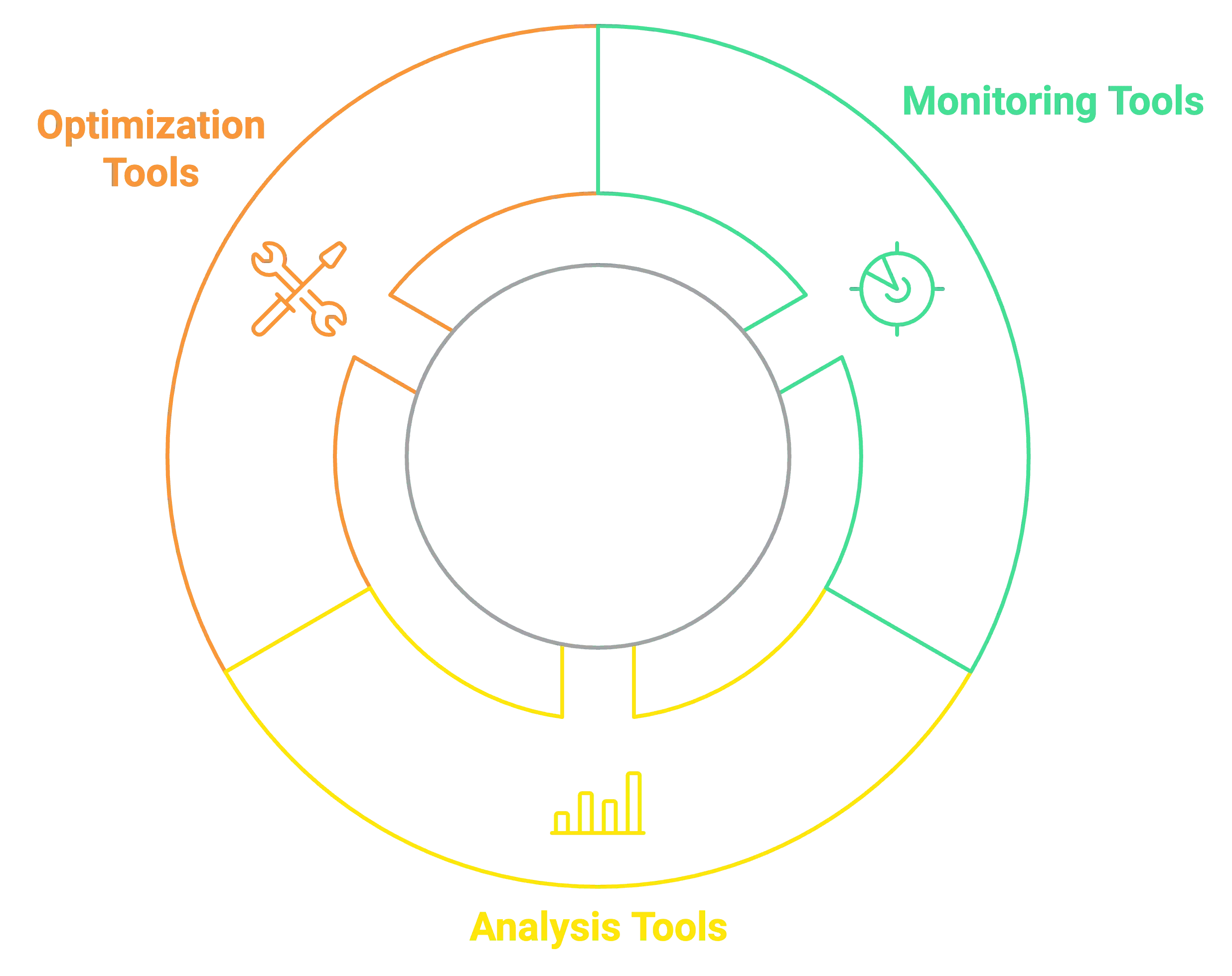
How do third-party indexing tools compare to Google’s own tools?
Third-party indexing tools often offer additional features and insights compared to Google’s native tools. Here’s a comparison:
| Feature | Google Tools | Third-Party Tools |
|---|---|---|
| Cost | Free | Often paid with free trials |
| Data Source | Direct from Google | May use APIs or web scraping |
| Update Frequency | Real-time to daily | Varies (hourly to weekly) |
| Advanced Analytics | Limited | Often more comprehensive |
| Cross-Search Engine Support | Google only | May support multiple search engines |
| Customization | Limited | Often highly customizable |
| Backlink Indexing | Not available | Available (e.g., Backlink Indexing Tool) |
What features should you look for in a website indexing tool?
When selecting a website indexing tool, consider the following essential features:
- Real-time indexation status monitoring
- Crawl error detection and analysis
- Sitemap generation and management
- Robots.txt file editor
- Integration with Google Search Console
- Custom indexation reports
- Indexation trend analysis
- Bulk URL submission capabilities
- Mobile indexation insights
- Schema markup validation
- Backlink indexing and monitoring (unique to tools like Backlink Indexing Tool)
How does the Backlink Indexing Tool enhance Google indexation?
Backlink indexing plays a critical role in improving a website’s visibility and rankings in Google search results. A specialized tool like the Backlink Indexing Tool can streamline this process by ensuring that valuable backlinks are recognized and indexed by Google efficiently.
This section explores the key features, processes, benefits, and API support that the tool offers to enhance Google indexation.
What are the key features of the Backlink Indexing Tool for indexation?
Backlink Indexing Tool provides several powerful features designed to improve the indexation rate of backlinks, which is crucial for boosting SEO efforts. Some of the key features include:
- Automated Backlink Submission: The tool automatically submits backlinks for indexing, reducing manual work and increasing efficiency.
- Indexing Reports: Comprehensive reports that show the current indexation status of submitted backlinks, helping users track progress.
- Bulk Submission: The ability to submit multiple backlinks at once, streamlining the process of ensuring all links are indexed.
- Advanced Crawling Mechanisms: The tool uses sophisticated crawling algorithms that help identify which backlinks need attention for faster indexing.
- Integration with Other SEO Tools: Seamless integration with popular SEO platforms allows for better tracking and analysis of indexed backlinks.
What are the benefits of using the Backlink Indexing Tool for indexation?
Using the Backlink Indexing Tool offers several key advantages for website owners and SEO professionals:
- Faster Indexation: By automating and optimizing the submission process, the tool helps get backlinks indexed by Google more quickly, leading to faster SEO results.
- Higher Indexation Rate: The tool’s advanced crawling mechanisms ensure a higher percentage of backlinks are recognized and indexed by Google, maximizing the impact of link-building efforts.
- Improved Search Rankings: Indexed backlinks can significantly improve a website’s rankings on Google, especially when linked to authoritative and relevant sources.
- Time and Resource Savings: Automating backlink submission reduces the time and resources required for manual link-building tasks, allowing teams to focus on other SEO strategies.
- Better SEO Insights: The detailed reports provided by the tool offer valuable insights into the indexation process, helping users refine their link-building strategies.
How does Backlink Indexing Tool’s API support indexation efforts?
Backlink Indexing Tool’s API offers advanced integration options for users who want to streamline indexation across various platforms and workflows. Key ways the API supports indexation efforts include:
- Seamless Integration: The API allows developers to integrate the tool’s indexation features directly into existing SEO platforms, automating backlink submission without the need for manual input.
- Real-Time Data Access: Users can access real-time data on backlink indexation status through the API, making it easier to track and adjust strategies based on live insights.
- Customization and Automation: The API enables custom automation workflows for submitting backlinks, managing indexation campaigns, and retrieving reports, allowing for greater flexibility and efficiency.
- Scalability: For larger websites with extensive link-building efforts, the API supports the bulk submission of backlinks, making it easier to scale indexation efforts without bottlenecks.
How can you monitor and maintain proper indexation over time?
Monitoring and maintaining proper indexation requires ongoing vigilance and regular assessment. To effectively track your website’s indexation status, focus on specific metrics and establish a consistent auditing schedule.
At Backlink Indexing Tool, we emphasize the importance of proactive indexation management to ensure optimal search engine visibility.
What metrics should you track for indexation health?
Indexation health metrics are key indicators that reveal how well search engines process and include your web pages in their index. The primary metrics to track include:
- Indexed pages count
- Crawl rate
- Crawl errors
- Index coverage
- Indexation speed
- Organic search traffic
- Click-through rate (CTR)
To effectively monitor these metrics, use tools like Google Search Console, which provides detailed reports on indexation status and performance.
Our Backlink Indexing Tool offers comprehensive charts and CSV reports to track the indexing process of your backlinks, complementing your overall indexation strategy.
| Metric | Description | Importance |
|---|---|---|
| Indexed pages count | Total number of pages in Google’s index | Indicates overall indexation success |
| Crawl rate | Frequency of Google bot visits | Shows how often Google discovers new content |
| Crawl errors | Number and types of errors during crawling | Highlights technical issues affecting indexation |
| Index coverage | Percentage of successfully indexed pages | Reveals the proportion of your site in the index |
| Indexation speed | Time for new/updated pages to be indexed | Indicates how quickly Google processes your content |
| Organic search traffic | Traffic from search engine results | Reflects the impact of indexation on visibility |
| Click-through rate | Percentage of users clicking on search results | Shows the effectiveness of your indexed pages |
How often should you audit your site’s indexation status?
The frequency of indexation audits depends on your website’s size, update frequency, and overall SEO goals. As a general guideline:
- Large, frequently updated websites: Conduct weekly or bi-weekly audits
- Medium-sized websites with regular updates: Perform monthly audits
- Small, relatively static websites: Quarterly audits may suffice
Increase audit frequency during significant changes, such as:
- Website redesigns or migrations
- Large-scale content updates
- Implementation of new SEO strategies
By consistently monitoring these metrics and conducting regular audits, you can identify and address indexation issues promptly, ensuring your website maintains optimal visibility in search results.
What are the future trends in Google indexation?
Google’s indexation practices are constantly evolving, driven by advancements in technology and changing user behaviors. Understanding future trends can help you stay ahead of the curve and optimize your indexation strategies accordingly.
How might AI and machine learning affect indexation practices?
Artificial intelligence (AI) and machine learning (ML) are poised to significantly impact Google’s indexation practices in the following ways:
- Improved content understanding: AI will enhance Google’s ability to comprehend context, intent, and semantic relationships within content.
- Real-time indexing: ML algorithms may enable faster, near-instantaneous indexing of new or updated content.
- Predictive crawling: AI could anticipate when pages are likely to be updated, optimizing crawl schedules.
- Enhanced quality assessment: Machine learning models may better evaluate content quality and relevance for indexing decisions.
- Personalized indexing: AI might tailor indexation based on user preferences and search history.
These advancements could lead to more efficient and accurate indexation processes, benefiting websites that consistently produce high-quality, relevant content.
What new indexation features or tools might Google introduce?
Google continually innovates to improve its indexation capabilities. Some potential new features or tools that Google might introduce include:
- Advanced indexing APIs: More sophisticated APIs for direct communication between websites and Google’s indexing system.
- Improved mobile-first indexing tools: Enhanced features to support mobile-optimized content indexation.
- Voice search optimization tools: Specific tools to help optimize content for voice search indexation.
- AI-powered content suggestion tools: Features that recommend content improvements to increase indexation likelihood.
- Real-time indexing notifications: Instant alerts when pages are indexed or encounter indexation issues.
- Enhanced schema markup support: More comprehensive tools for implementing and validating structured data.
While these are speculative, they align with Google’s ongoing efforts to improve search quality and user experience.
At Backlink Indexing Tool, we stay abreast of these developments to ensure our services remain at the forefront of indexation technology, helping you maintain a competitive edge in search engine visibility.
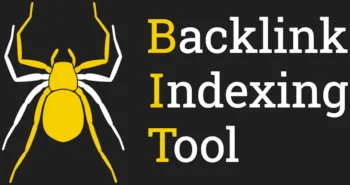
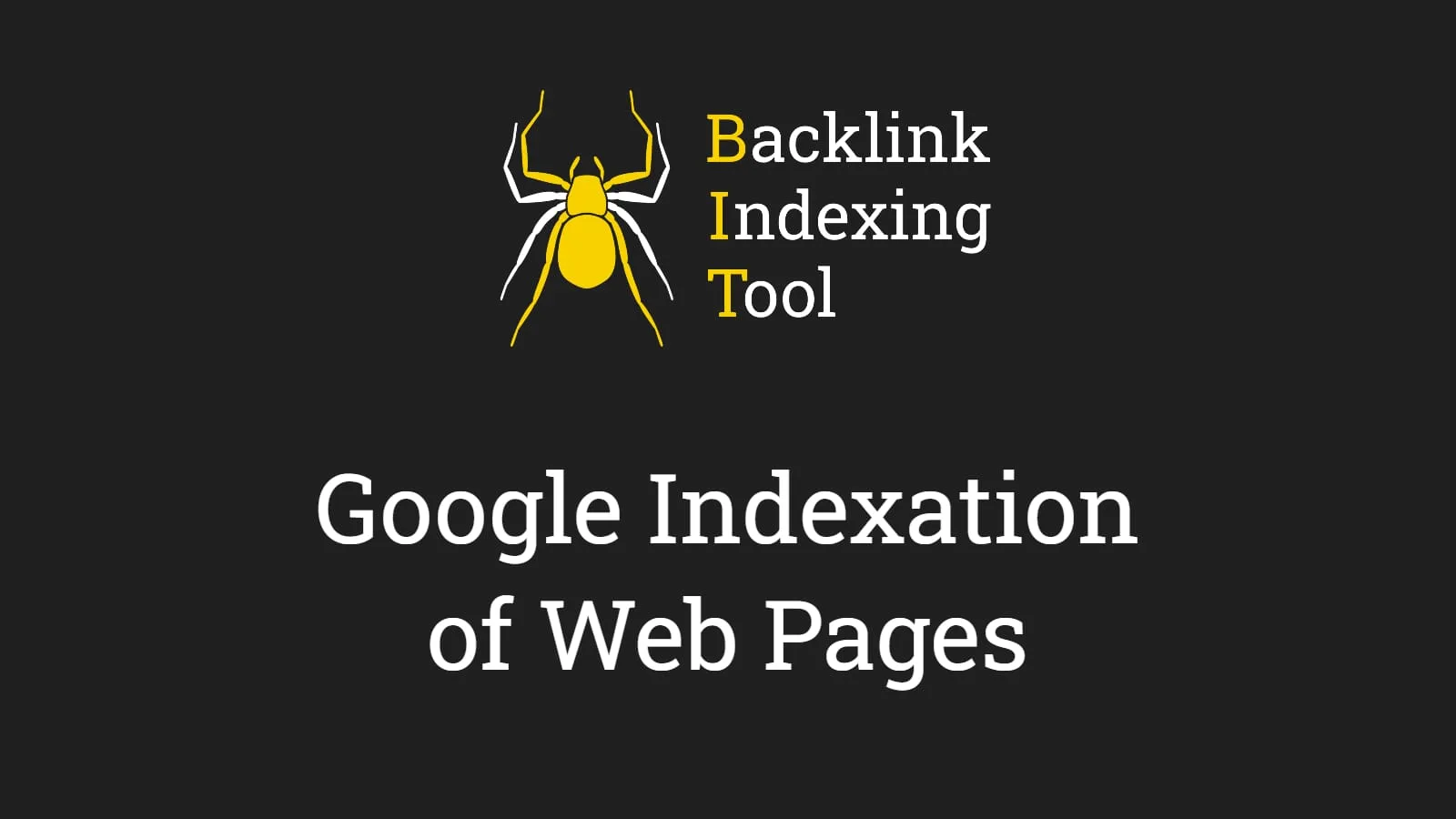
Leave a Reply